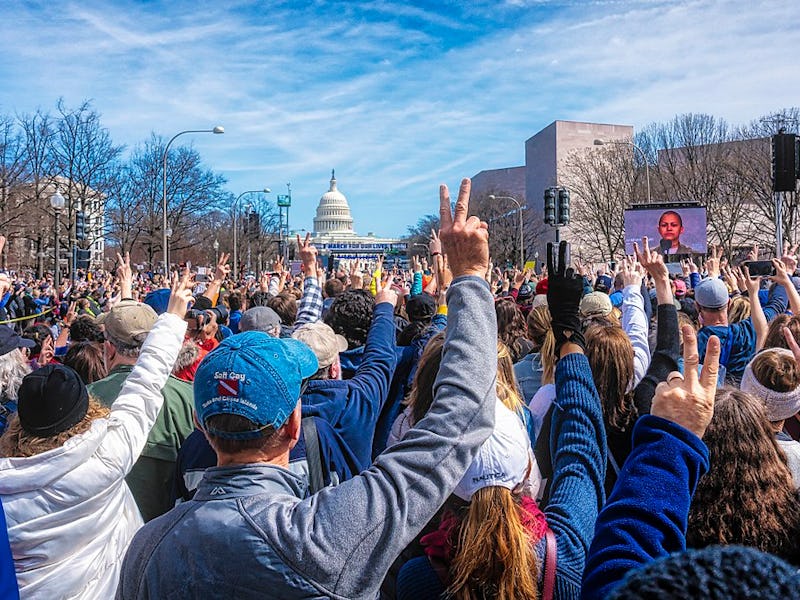Teenage Parkland Survivor Diagnoses America's Most Pressing Health Problem
"We’re not even really arguing something here. We’re just showing the data for people to use."

Parkland high school senior Rebecca Schneid isn’t a doctor yet, but she’s already diagnosed one of America’s most pressing public health issues: gun violence. She’s analyzed the data behind it, published her results and tragically, lived it herself, when a gunman opened fire on her school — Marjory Stoneman Douglas High School in Parkland, Florida — killing 17.
In October, Schneid co-authored a paper in the The American Journal of Medicine with Florida Atlantic University College of Medicine professor Charles Hennekens, Ph.D., identifying differing homicides in “sister cities,” Baltimore and New York. She dove into the project just months after the tragedy at her high school.
“My goal the last seven months has been to educate people about what happened to us and make sure it doesn’t happen again,” Schneid tells Inverse. “So this paper is a piece of that, a way of making sure that the medical community can have an understanding of what can prevent gun violence.” Her classmates have become household names throughout the country for their work on the March For Our Lives rally in Washington, D.C.
Schneid and Charles Hennikens at FAU
Schneid, a biologist at heart and editor of the student newspaper The Eagle Eye, contributes to the movement with her science-influenced brand of activism, using the rigor of statistics to drive home her singular message: America has a problem with gun violence, and mass shootings like the one she experienced herself are only the tip of the iceberg.
“Something that I love is this paper isn’t just about mass shootings — it’s not really about it at all,” she says. “That’s something that I’ve learned really in the last seven months. Mass shootings are really just a small percentage of gun violence in this country.”
Data, Not Politics
The paper focuses on trends in urban gun violence in Baltimore and New York, which from the outset appear to be two very different cities. From a gun violence perspective, they are indeed very different: Today, New York’s homicide rate is markedly lower than that of Baltimore. But that wasn’t always the case, and uncovering what changed over the years between the two cities, Schneid and Hennekens hope, can point to factors that could lead to more informed decision-making.
“This ‘Tale of Two Cities,’ if better understood, might point the way to the abolition of the ‘worst of times’ for Baltimore as well as many other U.S. cities as they seek to reduce their own high homicide rates,” said Hennekens. Despite their differences, the cities are deemed “peers” by the CDC on the basis of 19 different metrics, like unemployment and population density.
Their paper took death certificate data accumulated by the CDC to show that while homicide rates in New York City and Baltimore were roughly equivalent in 1979, the deaths per capita have diverged. Their results indicate that New York’s is now around 10 per 100,000 people, while Baltimore’s hovers around 40 out of every 100,000.
Though the paper looked only at homicide rates more broadly, there’s definitely a story about gun violence to be told here. The FBI reports that between 2012 and 2016, 11,004 of the 15,076 people murdered in the Untied States were killed by firearms.
The paper's comparison of homicide rates in Baltimore and New York between 1979 and 2016
But numerical analysis, says Schneid, is where this paper ends. She says the paper intentionally doesn’t go so far as to make policy recommendations. As the midterm elections draw closer and gun violence becomes an issue of increasingly vitriolic politics, she just wants to show a correlation that someone could use to inform an opinion.
“I think for me this is actually kind of refreshing. For the past seven months I’ve been saying my opinions and how I feel about what policies should be put in place. Obviously there’s data to back this idea that I have,” she says. “We’re not even really arguing something here. We’re just showing the data for people to use.”
Making a Diagnosis
Schneid has spent an immense amount of time speaking, analyzing and interpreting the effects of gun violence. Nevertheless, her goal remains to become some type of doctor in the future. She’s known this from an early age, when she made her first diagnosis on her grandparents’ dog. She suspected that he might have a urinary tract infection. When her grandparents’ took him to the vet, it turns out she was right.
“They said that I saved his life, but I think they were just trying to flatter me,” she says. “That’s one of the first moment where I thought ‘I can do this for a living.’”
Schneid’s first diagnosis might have been on a dog, but her most recent one appears in this paper, on two cities both grappling the the disease-like progression of violence. Her data shows that New York is showing signs of remission, but the country as a whole continues to suffer. This summer, the CDC reported that between 2014 and 2016, firearm-related homicides increased 31 percent.
This paper is an exercise in what she hopes to do with the rest of her life: learn as much as she can about subject, uncover objective truth, and use that to help people.